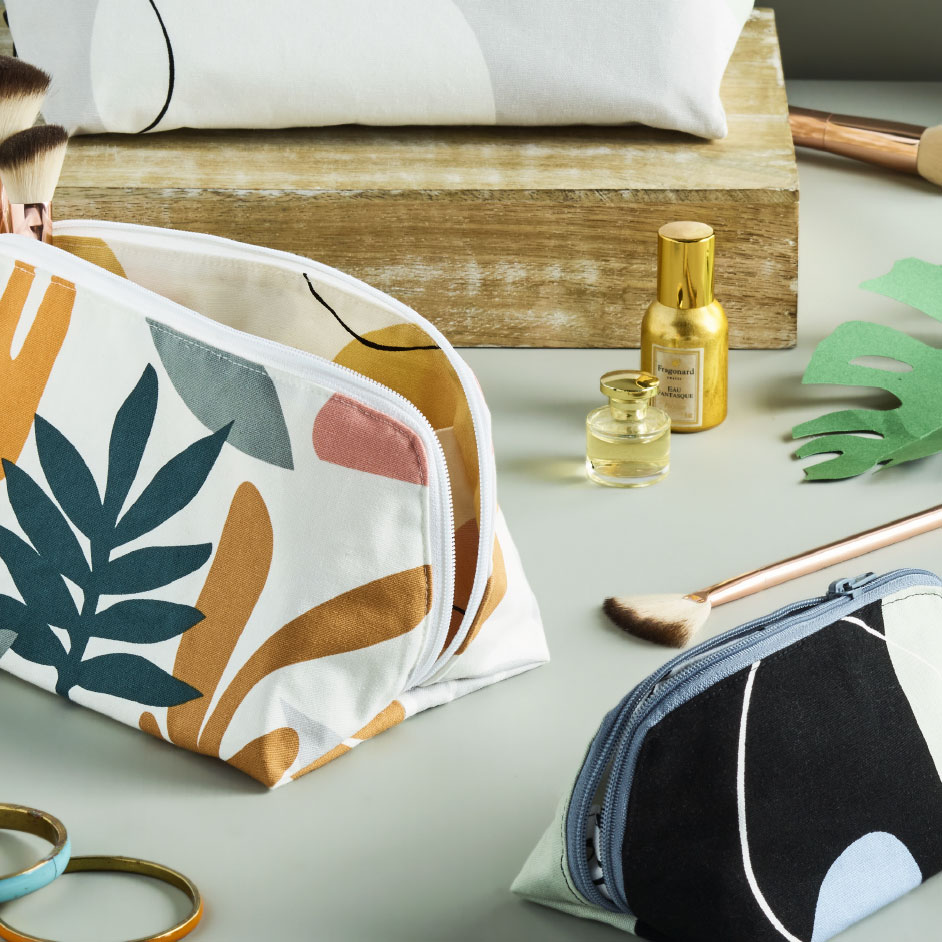 | ||
| Your browser is not supported. | ||
|
Please browse our site using any of the following options:
| ||
TOILETRIES BAGS 2

LEVEL: INTERMEDIATE
What you'll need:
Materials - per bag
Small
- Outer fabric - 20cm of 112cm wide Printed Cotton Duck/Drill
- Lining Fabric - 20cm of 112cm wide Printed Cotton Duck/Drill
- 20cm of fusible light/medium interfacing
- 40cm open ended zip
Medium
- Outer fabric - 30cm of 112cm wide Printed Cotton Duck/Drill
- Lining Fabric - 30cm of 112cm wide Printed Cotton Duck/Drill
- 30cm of fusible light/medium interfacing
- 50cm open ended zip
Large
- Outer fabric - 30cm of 112cm wide printed cotton duck/drill
- Lining Fabric - 30cm of 112cm wide printed cotton duck/drill
- 30cm of fusible light/medium interfacing
- 60cm open ended zip
- Scissors
- Pins
- Tape measure/ruler
- Sewing machine
- Sewing thread
- Iron
Note - 1cm seam allowance is used unless specified
INSTRUCTIONS
Step 1 - Enlarge template to size needed:
- Small 200%
- Medium 250%
- Large 300%
From the template provided cut out per bag
Fabrics with a nap:
- 2x outer fabric adding 1cm around outer edges and cut along base cutting line
- 2x lining fabric adding 1cm around outer edges and cut along base cutting line
- 2x side gussets from lining fabric
- 2x fusible interfacing
Fabrics without a nap:
- 1x outer fabric on the fold, adding 1cm around outer edges
- 1x lining fabric on the fold, adding 1cm around outer edges
- 2x side gussets from lining fabric
- 1x fusible pallon on the fold
Fuse interfacing pieces to the back of outer fabric pieces.
Step 2 - Mark the middle of top edge on each side of outer & lining fabrics. Mark the middle of the zip on the outer edges. Separate zip. Pin each side of the zip to the curved edges of the right side of outer fabric, aligning the middle marks on the outer edges of the fabric and zip. Sew zip to fabric using a zipper foot, leaving the ends of the zip overhanging, do not trim off. With right side facing, pin lining fabric over the outer fabric, aligning outer edges and middle markings. Sew together with zipper foot.
Clip curves and turn right way out. Lightly press flat and top stitch around outer edges of fabric 3mm in from zip.
Step 3 - Mark the middle of the longer edges of the gusset pieces. At these marks, fold fabric in half, press. Sew around outer edges leaving a 5-7cm opening in the middle base for turning out. Clip corners and turn right way out, press flat with opening allowances to inside. Top stitch along the top folded edges of the gusset pieces.
Step 4 - Replace zip head to zip and slowly do zip up with right side of the bag facing inwards. Flatten out each side opening of the bag matching the zip with the middle base seam. Pin in place. Place one of the pinned base edges on top of the opening side of one of the gussets, overlapping by 1cm. Pin and then sew together 7-8mm in from base edge. Trim excess zip back to edge of seam. Ensuring the zipper head is back into the bag body, repeat on the other side pinned edge with
remaining gusset piece. Fold gusset over onto the bag to enclose the raw seam, pin and sew in place 1cm in from folded edge.
Step 5 - Pin outer edges of gusset to the lining of the bag in desired position. (The angle of the edges of the gusset that is sewn to the lining will alter the opening of the bag. Try different angles to achieve the desired look before sewing in place) Hand sew in place. Turn bag right way out, press.




